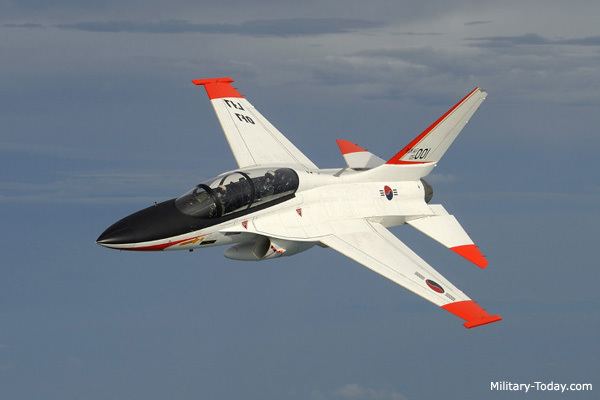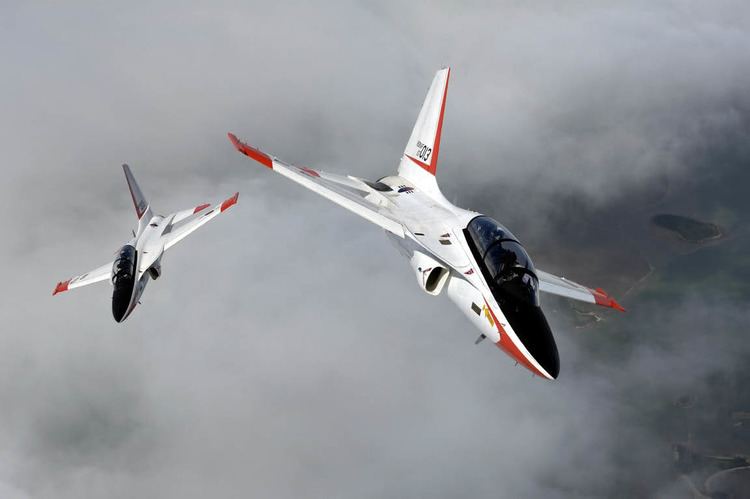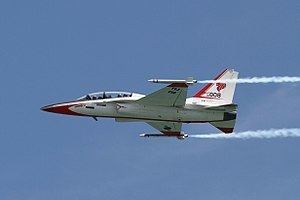Top speed 1,838 km/h Weight 6,470 kg | Range 1,851 km Length 13 m First flight August 20, 2002 | |
 | ||
Unit cost 21,000,000–30,000,000 USD (2012) | ||
The KAI T-50 Golden Eagle (골든이글) is a family of South Korean supersonic advanced trainers and light combat aircraft, developed by Korea Aerospace Industries (KAI) with Lockheed Martin. The T-50 is South Korea's first indigenous supersonic aircraft and one of the world's few supersonic trainers. Development began in the late 1990s, and its maiden flight occurred in 2002. The aircraft entered active service with the Republic of Korea Air Force (ROKAF) in 2005.
Contents
- Origins
- Improved versions
- Overview
- Avionics
- Armament and equipment
- Republic of Korea
- Indonesia
- Iraq
- Philippines
- Thailand
- Possible sales
- Failed bids
- Variants
- Operators
- Accidents and incidents
- Specifications
- References

The T-50 has been further developed into aerobatic and combat variants, namely T-50B, TA-50, and FA-50. The F-50 single-seat multirole fighter variant was considered. The T-50B serves with the South Korean air force's aerobatics team. The TA-50 light attack variant has been ordered by Indonesia. The Philippines ordered 12 units of the FA-50 variant. The T-50A is being marketed as a candidate for the United States Air Force's next-generation T-X trainer programme. Thailand ordered 4 units of the T-50 advanced trainer variant.

Origins

The T-50 program was originally intended to develop an indigenous trainer aircraft capable of supersonic flight, to train and prepare pilots for the KF-16 and F-15K, replacing trainers such as T-38 and A-37 that were then in service with the ROKAF. Prior South Korean aircraft programs include the turboprop KT-1 basic trainer produced by Daewoo Aerospace (now part of KAI), and license-manufactured KF-16. In general, the T-50 series of aircraft closely resembles the KF-16 in configuration.

The mother program, code-named KTX-2, began in 1992, but the Ministry of Finance and Economy suspended KTX-2 in 1995 due to financial constraints. The basic design of the aircraft was set by 1999. The development of the aircraft was funded 70% by the South Korean government, 17% by KAI, and 13% by Lockheed Martin.
The aircraft was formally designated as the T-50 Golden Eagle in February 2000. The T-50A designation was reserved by the U.S. military to prevent it from being inadvertently assigned to another aircraft model. Final assembly of the first T-50 took place between 15 January and 14 September 2001. The first flight of the T-50 took place in August 2002, and initial operational assessment from 28 July to 14 August 2003.
KAI and Lockheed Martin are currently pursuing a joint marketing program for the T-50 internationally. The ROKAF placed a production contract for 25 T-50s in December 2003, with aircraft scheduled to be delivered between 2005 and 2009. Original T-50 aircraft are equipped with the AN/APG-67(v)4 radar from Lockheed Martin. The T-50 is equipped with a GE F404 engine with Full Authority Digital Engine Control (FADEC) built under license by Samsung Techwin. Under the terms of the T-50/F404-102 co-production agreement, GE provides engine kits directly to Samsung Techwin who produces designated parts as well as performing final engine assembly and testing.
Improved versions
The program has expanded beyond a trainer concept to include the TA-50 advance trainer aircraft, as well as the FA-50 light attack aircraft similar to the multirole KF-16. The TA-50 variant is a more heavily armed version of the T-50 trainer, intended for lead-in fighter training and light attack roles. It is equipped with the Elta EL/M-2032 fire control radar. The TA-50 is designed to operate as a full-fledged combat platform for precision-guided weapons, air-to-air missiles, and air-to-ground missiles. The TA-50 can mount additional utility pods for reconnaissance, targeting assistance, and electronic warfare. Reconnaissance and electronic warfare variants are also being developed, designated as RA-50 and EA-50.
The FA-50 is the most advanced version of the T-50, possessing more internal fuel capacity, enhanced avionics, a longer radome and a tactical datalink. It is equipped with a modified Israeli EL/M-2032 pulse-Doppler radar with Korean-specific modifications by LIG Nex1. The engine could be either Eurojet EJ200 or General Electric F414, upgraded to 20,000 lb or 22,000 lb thrust, roughly 12–25% higher than the F404's thrust; and are offered to prospective customers for the T-50. The radar of the FA-50 has a range two-thirds greater than the TA-50's radar. The EL/M-2032 was initially chosen over Lockheed Martin's preferred AN/APG-67(V)4 and SELEX Vixen 500E active electronically scanned array (AESA) radars. Other AESA radars such as Raytheon Advanced Combat Radar and Northrop Grumman's Scalable Agile Beam Radar are options for future production, and may be shared with the radar chosen for USAF and ROKAF F-16 fighters. Samsung Thales is also independently developing a domestic multi-mode AESA radar for the FA-50.
In December 2008, South Korea awarded a contract to KAI to convert four T-50s to FA-50 standard by 2012. In 2012, the ROKAF ordered 20 FA-50 fighters to be delivered by the end of 2014. The maiden flight of the FA-50 took place in 2011. 60 FA-50 aircraft are to be produced for the ROKAF from 2013 to 2016. KAI received a 1.1 trillion won ($1 billion) order for FA-50 fighter aircraft in May 2013.
In December 2015, KAI announced and revealed the new KAI-LM T-50 T-X upgrade intended to compete in the U.S. T-X program that will start testing in 2016. This variant features a dorsal hump for extra internal fuel and an aerial refuelling receptacle, large area display (LAD), and embedded ground training systems.
Overview
The T-50 Golden Eagle design is largely derived from the F-16 Fighting Falcon, and they have many similarities: use of a single engine, speed, size, cost, and the range of weapons. KAI's previous engineering experience in license-producing the KF-16 was a starting point for the development of the T-50.
The trainer has seating for two pilots in a tandem arrangement. The high-mounted canopy developed by Hankuk Fiber is applied with stretched acrylic, providing the pilots with good visibility, and has been tested to offer the canopy with ballistic protection against 4-lb objects impacting at 400 knots. The altitude limit is 14,600 metres (48,000 ft), and airframe is designed to last 8,000 hours of service. There are seven internal fuel tanks with capacity of 2,655 litres (701 US gal), five in the fuselage and two in the wings. An additional 1,710 litres (452 US gal) of fuel can be carried in the three external fuel tanks. T-50 trainer variants have a paint scheme of white and red, and aerobatic variants white, black, and yellow.
The T-50 uses a single General Electric F404-102 turbofan engine license-produced by Samsung Techwin, upgraded with a FADEC system jointly developed by General Electric and KAI. The engine consists of three-staged fans, seven axial stage arrangement, and an afterburner. The aircraft has a maximum speed of Mach 1.5. Its engine produces a maximum of 78.7 kN (17,700 lbf) of thrust with afterburner. The more powerful F414 and EJ200 engines have been suggested as the new engine for the T-50 family.
Avionics
The T-50's central processing unit and its operating system are developed by MDS Technology. The T-50's NEOS avionics operating system is the first and only real-time operating system to be developed by an Asian company, and holds both DO-178B and IEEE POSIX certification. Samsung Thales and LIG Nex1 are the main avionics and electronic warfare equipment developers for T-50 and its variants. Other South Korean companies and defense institutes such as DoDAAM Systems, Aeromaster, Intellics, and Korea Institute of Defense Analysis are responsible for the aircraft's secondary avionics and embedded systems, including store management computers, avionics testing equipment, flight data recorders, portable maintenance aids, data analysis software, post-flight data processing system, aircraft structure and engine management software, and mission planning and support systems. The TA-50 version is equipped with an ELTA EL/M-2032 fire control radar.
The T-50 is equipped with a Honeywell H-764G embedded global positioning/inertial navigation system and HG9550 radar altimeter. The aircraft is the first trainer to feature triple-redundant digital fly-by-wire controls. The cockpit panels, switches, and joysticks are produced by South Korea's FirsTec and Sungjin Techwin, head-up display by DoDaaM Systems, and multi-function display by Samsung Thales. Other South Korean subcontractors such as Elemech, Dawin Friction, and Withus cooperate in T-50 components production. Hanwha supplies the mechanical parts for the flight control system, and WIA supplies the undercarriage.
Armament and equipment
The TA-50 version mounts a three-barrel cannon version of the M61 Vulcan internally behind the cockpit, which fires linkless 20 mm ammunition. Wingtip rails can accommodate the AIM-9 Sidewinder missile, a variety of additional weapons can be mounted to underwing hardpoints. Compatible air-to-surface weapons include the AGM-65 Maverick missile, Hydra 70 and LOGIR rocket launchers, CBU-58 and Mk-20 cluster bombs, and Mk-82, −83, and −84 general purpose bombs.
FA-50 can be externally fitted with Rafael's Sky Shield or LIG Nex1's ALQ-200K ECM pods, Sniper or LITENING targeting pods, and Condor 2 reconnaissance pods to further improve the fighter's electronic warfare, reconnaissance, and targeting capabilities. Other improved weapon systems include SPICE multifunctional guidance kits, Textron CBU-97/105 Sensor Fuzed Weapon with WCMD tail kits, JDAM, JDAM-ER for more comprehensive air-to-ground operations, and AIM-120 missiles for BVR air-to-air operations. FA-50 has provisions for, but does not yet integrate, Python and Derby missiles, also produced by Rafael, and other anti-ship missiles, stand-off weapons, and sensors to be domestically developed by Korea. The South Korean military is reviewing whether to arm the FA-50 with a smaller version of the KEPD 350 missile to give it a stand-off engagement capability of 400 km (250 mi).
Republic of Korea
In 2011, the first squadron with the TA-50, the T-50's light attack variant, become operational with the ROKAF. The ROKAF's Black Eagles aerobatic team operates the T-50B version. In 2014, the FA-50 was officially deployed by the ROKAF with President Park Geun-hye officially leading a ceremony during which a flight demonstration was held showing its capabilities. 20 FA-50s was assigned its own Air Force wing. 60 FA-50s were ordered by ROKAF. On 9 October 2014, an FA-50 successfully test fired an AGM-65 Maverick at a stationary target, a retired ship.
Indonesia
Indonesia had been considering the T-50, along with four other aircraft to replace its BAE Systems Hawk Mk 53 trainer and OV-10 Bronco attack aircraft. In August 2010, Indonesia announced that T-50, Yak-130 and L-159 were the remaining candidates for its requirement for 16 advanced jet trainers. In May 2011, Indonesia signed a contract to order 16 T-50 aircraft for US$400 million. The aircraft is to feature weapons pylons and gun modules, enabling light attack capabilities. The Golden Eagles are to replace the Hawk Mk 53 in Indonesian Air Force service. Indonesia's version has been designated T-50i. Deliveries began in September 2013. The last pair of T-50i aircraft were delivered in January 2014.
Iraq
Iraq was negotiating the acquisition of T-50 trainer jets, having first publicly expressed official interest during the Korea-Iraq summit in Seoul on 24 February 2009. In April 2010, Iraq reopened the jet lead-in fighter-trainer competition for 24 aircraft, in which TA-50 competed. In December 2013, it was announced that Iraq signed a contract for 24 aircraft of the FA-50 variant designated T-50IQ, plus additional equipment and pilot training over the next 20 years. Deliveries were to begin in April 2016, with all aircraft to be delivered over the next 12 months.
Philippines
The Philippine Air Force chose 12 KAI TA-50 aircraft to fulfill its requirement for a light attack and lead-in fighter trainer aircraft. The Department of National Defense (DND) announced the selection of the type in August 2012. Funding for 12 aircraft was approved by Congress on September 2012, but by late January 2013, state media reported that the FA-50, not the TA-50 as previously reported, was selected for the procurement.
In October 2013, President Aquino said the DND was close to finalizing the FA-50 deal, and on 19 October 2013, President Aquino and President Park Geun-hye of South Korea signed a memorandum of understanding (MoU) with provisions for acquisitions. On 13 February 2014, President Aquino approved the payment scheme for purchasing 12 lead-in fighter trainers with P18.9 billion ($415.7 million) budgeted. On 28 March 2014, the Philippines' Department of National Defense signed a contract for 12 FA-50 light attack aircraft worth P18.9 billion (US$421.12 million).
Deliveries began in November 2015 and are planned to end in 2017. The first four FA-50PH aircraft delivered were displayed on 1 December 2016.
Plans call for 3 to 4 of 12 aircraft to be fitted with capability for beyond visual range (BVR) intercept. In March 2015, Stockholm International Peace Research Institute (SIPRI) reported that the Philippines plans to order additional FA-50s, which is supported by the PAF flight plan 2028 that lists another 12 FA-50s planned for the future.
On 26 January 2017, the Philippine Air Force used the FA-50PH in combat for the first time when two aircraft conducted a nighttime strike on terrorist hideouts in Butig, Lanao del Sur province in Mindanao.
Thailand
In September 2015, the Thai government chose the KAI T-50 variant for its air force over the Chinese Hongdu L-15 to replace its aging L-39 Albatros trainers. The 4 T-50TH aircraft are scheduled to be delivered by March 2018.
Possible sales
The Spanish Air Force is interested in a cooperation agreement with South Korea for use of training aircraft, including the T-50.
The United Arab Emirates (UAE) is seeking 35–40 fighter-trainers. In February 2009, the UAE selected the M-346 over the T-50. In January 2010, the UAE reopened the trainer contest. In 2011, it was confirmed that the T-50 was still competing for the UAE purchase.
In the U.S., the T-50 is one of the contenders for the U.S. Air Force's T-X program, with an opportunity to export 300 to 1,000 aircraft.
Azerbaijan has expressed interest in purchasing T-50 trainers.
Brunei has expressed interest in the FA-50.
South Korea also plans to offer the FA-50 to Colombia and Peru.
The Pakistan Air Force is considering purchase of the South Korean KAI T-50 Lead In Fighter Trainer (LIFT) to revamp its air force training program.
Vietnam looks to purchase FA-50 light fighters from U.S. and South Korea.
Taiwan is looking to replace its current fleet of AT-3 jet trainers and F-5 LIFT planes with 66 advanced trainers, the Taiwanese Air Force released a request for information (RFI) and two companies have responded including Lockheed Martin for the T-50 and Alenia Aermacchi's M-346 responded to the request. The planes are expected to be license produced in Taiwan with a local partner firm, and the overall estimated contract value is 69 billion New Taiwan dollars (US$2.2 billion). However, Taiwan decided to build 66 XT-5 Blue Magpie supersonic trainers based on Taiwan's old indigenous fighter for NT$68.6 billions instead of selecting the T-50 or M-346.
The airplane is also being offered to Croatia, which is deciding on a replacement for its aging fleet of MiG-21BIS aircraft.
The Argentine Air Force is evaluating the FA-50 as a potential new platform.
Failed bids
Singapore evaluated the T-50 against the Italian Alenia Aermacchi M-346 and the BAE Systems Hawk for a $500 million trainer acquisition program contract for 12–16 aircraft. The Singapore Ministry of Defense eventually selected the M-346 aircraft ahead of T-50 and BAE Hawk in July 2010.
Israel had been evaluating the T-50 as a possible replacement for its Douglas TA-4H Skyhawk trainers since 2003. On 16 February 2012, Israel announced its decision to procure 30 M-346s instead.
In October 2015, the U.S. denied the sale to Uzbekistan of 12 KAI T-50s with US engines and certain avionic systems.
Variants
Operators
Accidents and incidents
Specifications
Data from Korea Aerospace, Lockheed Martin
General characteristics
Performance
Armament
Avionics
